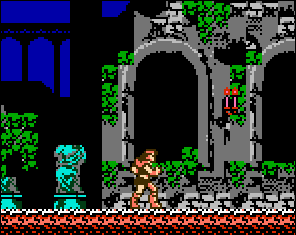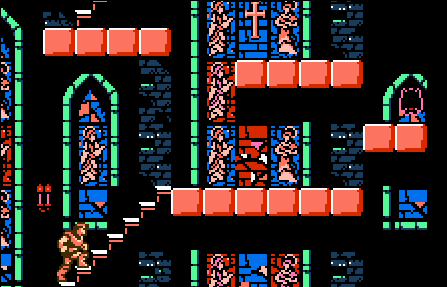Bad Controls and Castlevania 3
There are some quirks of modern games that seem very strange if one pauses to think about them, but are so ubiquitous that one rarely does. For example, it’s a staple of modern platformers that one can change direction in mid-air while jumping; this may sound strange if you don’t play a lot of platformers, but it is so intuitive that I’d never questioned this peculiarity of platforming physics until I played a game that didn’t have it.
In Castlevania 3 for the NES, when one makes a jump, as in real life, it’s a commitment. One cannot decide to stop or turn back half-way through.

Our hero Trevor Belmont must complete his jump arcs and cannot turn around.
In theory, this may sound exciting, but in practice, it’s just annoying. Since there is no way to control the height or length of the jump, as the NES didn’t have analogue input, I frequently found myself jumping over the platform I intended to land on, or jumping right into the enemy I was trying to avoid. For a game about fighting vampires, so much of the challenge in this game comes from fighting the controls.
Perhaps the ability to change direction in mid-air or reset your y-velocity to zero is a stand-in for the fact that it would be too cumbersome to convey to the game the exact parameters of a jump before one makes it. Or perhaps it was just included for players like me who get cold feet part-way through jumping over a pit. Regardless, being able to control one’s trajectory mid-air is a vast improvement over the Castlevania system.
There are many other examples of these bad controls in the Castlevania games which have since been improved on in more modern games. For example, in Castlevania, when the player climbs stairs, they are suddenly, perplexingly, unable to jump off the stairs. Or when crouching, one cannot turn around.
Perhaps the worst offender of the bad control scheme is that after getting hit by an enemy, the player is knocked back ridiculousuly far, usually into a pit and to their death. This is something that one sees in a lot of games, even in Mega Man, which is renowned for its good control scheme. The knockback in Mega Man isn’t quite as bad, but still, a lot of the challenge comes from enemies which pop out at you just as you’re leaping over a pit, causing the player to die a frustrating death instead of the usual penalty of taking a small amount of damage.

Video games have taught me that bats are a major threat to human life.
It’s not always just the controls that are frustrating; sometimes it’s basic game-design decisions like game-overs taking you back to the beginning of the game instead of just back to the beginning of the level. This sort of design probably evolved out of arcade games (where there is a monetary incentive to prevent the player from winning) and was wasn’t thought through for home console releases. Or perhaps game designers wanted to make their games as nail-bitingly hard as possible in order to provide what they viewed as an adequate challenge to the player. Personally, I like a hefty amount of challenge, but being sent back all the way to the beginning of the game is overkill for me. Fortunately, Castlevania 3 does not do this.
My brother suggests that maybe there is a market for taking old NES games and improving their control schemes to make them less frustrating for modern audiences. Obviously, this would have to be done by whoever has the rights to those games and not amateurs like me, but in my next post, I’ll take a stab – so to speak – at hacking Castlevania 3 in order to improve its control scheme.